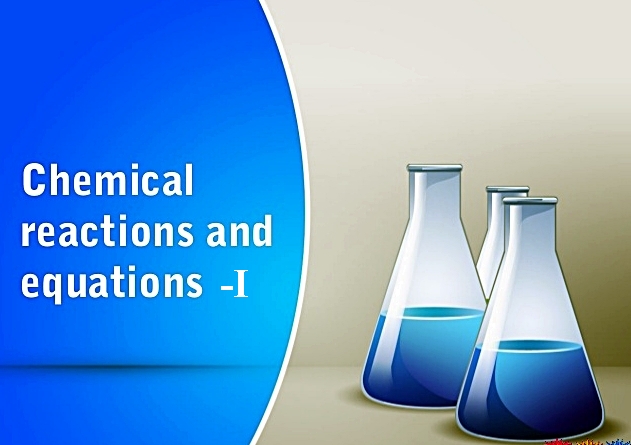Salt -IV
Salts are
the ionic compounds which are produced after the neutralization reaction
between acid and base.
Family of Salt -
Salts
having common acidic or basic radicals are said to belong to same family.
Example:
- Sodium
chloride (NaCl) and Calcium chloride (CaCl2) belong to chloride
family.
- Sodium
sulphate (Na2SO4), Potassium sulphate (K2SO4)
and Aluminium sulphate (Al2(SO4)3) belong to
sulphate family.
- Calcium
chloride (CaCl2) and calcium sulphate (CaSO4) belong
to calcium family.
- Zinc
chloride (ZnCl2) and Zinc sulphate (ZnSO4) belong to
zinc family.
Conduction of Electricity -
As we saw
that acid and base solution can conduct electricity due to formation of mobile
ions.
Similarly
when salt is dissolved in water, it ionizes to form ions. And these ions are
responsible to conduct electricity same as in the case of acids and bases.
For
example, if sodium chloride (NaCl) is dissolved in water, it ionizes to form Na+
and Cl- ions.
NaCl (aq)
Na+ + Cl-
Hence
salts can also conduct electricity.
pH Value of Acidic, Basic
and Neutral Salt -
1.
Neutral Salt -
Salts
produced because of reaction between strong acid and strong base are neutral in
nature. The pH value of such salts is equal to 7, i.e. neutral.
Examples
of such type of salts are sodium chloride, sodium sulphate, potassium chloride,
etc.
- Sodium chloride (NaCl) is formed after the reaction between hydrochloric acid (a strong acid) and sodium hydroxide (a strong base).
2.
Basic Salt –
Salts which are formed after the reaction between
weak acid and strong base are called basic salt. The pH value of acidic salt is
greater than 7.
3.
Acidic salt -
Salts
which are formed after the reaction between a strong acid and weak base are
called acidic salt. The pH value of acidic salt is lower than 7.
Cause of
formation of acidic, basic and neutral salt -
- When
equally strong acid and base react they fully neutralize each other. Due
to this a neutral salt is formed in this case.
- When
a strong acid reacts with a weak base, the base is unable to fully
neutralize the acid. Due to this an acidic salt is formed in this case.
- When
a strong base reacts with a weak acid, the acid is unable to fully
neutralize the base. Due to this a basic salt is formed in this case.
Characteristics of
salt:
- Most
of the salts are crystalline solid.
- Salts
may be transparent or opaque.
- Most
of the salts are soluble in water.
- Solution
of salts conducts electricity. Salts conduct electricity in their molten
state also.
- The
salt may be salty, sour, sweet, bitter and savory.
- Neutral
salts are odourless.
- Salts
can be colourless or of coloured.
Water of crystallization
Many
salts contain water molecule and are known as hydrated salts. The water
molecules present in salt is known as water of crystallization. For example;
copper sulphate pentahydrate (CuSO4.5H2O), ferrous
Sulphate heptahydrate (FeSO4.7H2O), Plaster of Paris etc.
1.
Copper sulphate pentahydrate (CuSO4.5H2O):
- Blue
colour of copper sulphate pentahydrate is due to presence of 5 molecules
of water.
- When
copper sulphate pentahydrate is heated, it loses water molecules and turns
into grey-white colour, which is known as anhydrous copper sulphate.
- After
adding water; anhydrous copper sulphate becomes blue again.
2.
Plaster of Paris:
Plaster
of Paris is obtained by heating of gypsum, a hydrated salt of calcium.
After
addition of water, Plaster of Paris is again converted into gypsum.
Plaster
of Paris is used in making of toys, designer false ceiling, etc. Doctors use
Plaster of Paris to set the fractured bone.
1)
Common Salt (Sodium Chloride) -
Sodium
chloride (NaCl) is also known as common salt or table salt. It is formed after
the reaction between sodium hydroxide and hydrochloric acid.
NaOH +
HCl → NaCl + H2O
- It
is a neutral salt.
- The
pH value of sodium chloride is about 7.
- Sodium
chloride is used in cooking as well as to prepare many other important
chemicals such as chemicals used in manufacturing industries.
Methods of obtaining Sodium Chloride -
1.
From sea water by evaporation: Spread
sea water in open. In summer season, water of seawater evaporates in atmosphere
and we get sodium chloride.
Making Other Chemical from Common Salt -
Sodium Hydroxide -
- Sodium
hydroxide is a strong base. It is also known as caustic soda.
- It
is obtained by the electrolytic decomposition of solution of sodium
chloride (brine).
- In
the process of electrolytic decomposition of brine (aqueous solution of
sodium chloride), brine decomposes to form sodium hydroxide.
- In
this process, chlorine is obtained at anode and hydrogen gas is obtained
at cathode as byproducts. This whole process is known as Chlor-Alkali
process.
Use of
products after the electrolysis of brine:
Hydrogen gas is used as fuel, margarine, in making of ammonia
for fertilizer, etc.
Chlorine gas is used in water treatment, manufacturing of PVC,
disinfectants, CFC, pesticides. It is also used in manufacturing of bleaching
powder and hydrochloric acid.
Sodium hydroxide is used in de-greasing of metals, manufacturing of
paper, soap, detergents, artificial fibres, bleach, etc.
Bleaching Powder (CaOCl2) -
Bleaching
powder is also known as chloride of lime. It is a solid and yellowish white in
colour. Bleaching powder can be easily identified by the strong smell of
chlorine.
When
calcium hydroxide (slaked lime) reacts with chlorine, it gives calcium
oxychloride (bleaching powder) and water is formed.
Water
solution of bleaching powder is basic in nature.
The term
bleach means removal of colour. Bleaching powder is often used as bleaching
agent. It works because of oxidation. Chlorine in the bleaching powder is
responsible for bleaching effect.
Use of
bleaching powder:
- Bleaching
powder is used as disinfectant to clean water, moss remover, weed killers,
etc.
- Bleaching
powder is used for bleaching of cotton in textile industry, bleaching of
wood pulp in paper industry.
- Bleaching
powder is used as oxidizing agent in many industries, such as textiles
industry, paper industry, etc.
Baking Soda (NaHCO3) -
Baking
soda is another important product which can be obtained using by products of
chlor-alkali process. The chemical name of baking soda is sodium hydrogen
carbonate (NaHCO3) or sodium bicarbonate.
Baking
soda is obtained by the reaction of brine with carbon dioxide and ammonia. This
is known as Solvay process.
In this
process, calcium carbonate is used as the source of CO2 and the
resultant calcium oxide is used to recover ammonia from ammonium chloride.
Properties of sodium bicarbonate:
- Sodium
bicarbonate is white crystalline solid, but it appears as fine powder
- Sodium
hydrogen carbonate is amphoteric in nature
- Sodium
hydrogen carbonate is sparingly soluble in water
- Thermal
decomposition of sodium hydrogen carbonate (baking soda)
- When
baking soda is heated, it decomposes into sodium carbonate, carbon dioxide
and water
Sodium
carbonate formed after thermal decomposition of sodium hydrogen carbonate;
decomposes into sodium oxide and carbon dioxide on further heating.
This
reaction is known as dehydration reaction.
Use of
Baking Soda:
- Baking
soda is used in making of baking powder, which is used in cooking as it
produces carbon dioxide which makes the batter soft and spongy.
- Baking
soda is used as antacid.
- Baking
soda is used in toothpaste which makes the teeth white and plaque free.
- Baking
soda is used in cleansing of ornaments made of sliver.
- Since,
sodium hydrogen carbonate gives carbon dioxide and sodium oxide on strong
heating, thus it is used as fire extinguisher.
Baking powder -
Baking
powder produces carbon dioxide on heating, so it is used in cooking to make the
batter spongy. Although baking soda also produces carbon dioxide on heating,
but it is not used in cooking because on heating; baking soda produces sodium
carbonate along with carbon dioxide. The sodium carbonate; thus produced; makes
the taste bitter.
Baking
powder is the mixture of baking soda and a mild edible acid. Generally,
tartaric acid is mixed with baking soda to make baking powder.
When
baking powder (mixture of baking soda and an edible acid) is heated, the sodium
carbonate formed because of heating of baking soda neutralizes after reacting
with tartaric acid and sodium tartarate salt is formed. The smell of sodium
tartarate is pleasant and taste is good. This makes the cake or any other food
tasty.
Washing Soda (Sodium carbonate) -
Sodium
carbonate is manufactured by the thermal decomposition of sodium hydrogen
carbonate obtained by Solvay process. The sodium carbonate obtained in this
process is dry. It is called soda ash or anhydrous sodium carbonate. Washing
soda is obtained by rehydration of anhydrous sodium carbonate.
Since
there are 10 water molecules in washing soda, hence it is known as Sodium
bicarbonate decahydrate.
Sodium
carbonate is a crystalline solid and it is soluble in water when most of the
carbonates are insoluble in water.
Use of
sodium carbonate:
- It
is used in cleaning of cloths; especially in rural areas.
- In
making of detergent cake and powder.
- In
removing permanent hardness of water.
- It
is used in glass and paper industries.
Plaster of Paris:
Plaster
of Paris is obtained by heating of gypsum, a hydrated salt of calcium.
After
addition of water, Plaster of Paris is again converted into gypsum.
Plaster
of Paris is used in making of toys, designer false ceiling, etc. Doctors use
Plaster of Paris to set the fractured bone.
Base & Alkali - Alkalis are water soluble bases.
Bases in
which complete dissociation of hydroxide ion takes place are called strong
base. In alkali; complete dissociation of hydroxide ions takes place so they
are considered as strong base. But it is not perfectly well defined that which
substance is consider in category of Alkali and which is not.

















2 Comments
The casino with roulette machines | Vannienailor4166 Blog
ReplyDeleteCasino roulette game is worrione.com one herzamanindir of the most popular casino games in 1xbet login Malaysia. It offers the latest games with https://vannienailor4166blog.blogspot.com/ the best odds, with big payouts and easy filmfileeurope.com
It is safe and simple to deposit and withdraw money from the app, and in case might have|you might have|you may have} any queries, the shopper support staff is at all times willing to help. This distinctive and helpful device allows to rapidly and easily propose limits for deposits or losses to make sure your experience is as fun and secure as potential. Hop over to casino-bros.com and browse detailed evaluations of all notable on-line casinos and see how other individuals fared in them. You will see detailed evaluations, an summary of all bonuses a on line casino 파라오카지노 도메인 provides, details about deposits and withdrawals, and all sorts of other necessary info. Armed with all this, selecting a casino shall be a much simpler course of.
ReplyDelete